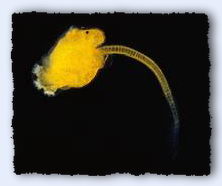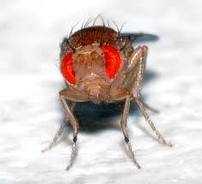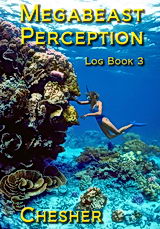Teleology and Inheritance of Acquired Characteristics
Tunicates, like
the ones I photographed in Palau,
are supposed to be the first creatures to
develop a notochord and are thus thought to
be the distant ancestors of all creatures
that have a vertebral column - the backbone
of fish, reptiles, and mammals.
These are the adult form, only about a centimeter high, attached to an old dead section of coral. The basket inside the translucent tunic is a ribbed cage lined with cilia. These beat to drive water currents through the tunic, entering one end of the basket and exiting through the large hole. Microscopic plants and animals get trapped on the mucous lining the basket's ribs and are moved by ciliary action into the digestive tract.
 Young
tunicates are wiggly tadpole like creatures, propelling themselves through Sea by wagging
their famous notochords. If evolutionary biologists are correct, their soft, flexible,
cartilaginous notochord ties their thread of awareness to fish, reptiles, mammals and to
us.
Young
tunicates are wiggly tadpole like creatures, propelling themselves through Sea by wagging
their famous notochords. If evolutionary biologists are correct, their soft, flexible,
cartilaginous notochord ties their thread of awareness to fish, reptiles, mammals and to
us.
Tunicates are aware of their surroundings and their active young even more so as they must avoid predators while swimming in the open sea and somehow locate a good spot on the reef to settle down and become sedentary.
But they are nowhere near as clever as their more distant children,
like fish or us.
Teleology & the Inheritance of Aquired Characteristics
The idea that creatures evolve their perfect and wildly imaginative forms for a predesigned reason is called teleology.
Teleology is thought to be easily disproved and has been relegated again and again to the dustbins of dumb ideas.
Fish did not, for example, hold a committee meeting and decide to grow fins so that they could swim.
A second, related idea about evolution was introduced by Jean Baptiste Lamarck in 1806. He believed physical (or mental) characteristics acquired during a creature's life could be passed one generation to the next. Back then nobody liked the idea of evolution at all and they were quick to disprove Lamarck with the snide but convincing argument that no uncircumcised male humans were born and foreskins have not even gotten shorter despite several thousands of years of lopping them off at birth.
In a way, both these debunked and ridiculed ideas are correct if you consider populations rather than individuals. Little boys may not be born without foreskins but they don't keep them long. And they lose them for a reason - to cull out hemophiliacs. Humans are special cases, we all agree. No other creature cuts off parts of the sex organ to cull hemophiliacs.
Fish evolved from earlier creatures that swam to chase prey or avoid being prey. They changed their behavior patterns to meet new challenges from predators, seek new prey, attract mates or hide from enemies, live in areas of strong currents or hide in tiny caves.
The change in behavior then gave slight advantages to populations of fish with fin characteristics best suited to that kind of behavior. In any population there were some fish that, by chance, happened to have better suited fins than their siblings.
The better endowed fish had more young and the improved fin shapes became more common within that population. Thus, over a period of hundreds, perhaps thousands of generations, the fins were shaped by the fish behavior into specific shapes and uses.
Try or Die
Behavior changes always leads the process of evolutionary selection. From this viewpoint, the specialized fins of a particular species of fish did evolve for a purpose - survival of the fish within a specific envelope of relationships. The difference is that the purpose was not determined in advance, but is a pre-set condition of life that demands that organisms try very hard to survive. This is a behavioral characteristic, not a morphological one. But it is still deterministic, especially when applied to the population as a whole.
As for aquired characteristics, while the adventures of a single fish may not be passed along to its progeny, there can be no doubt that behavior patterns acquired by a population of fish do indeed get passed along to the progeny, if only by the necessity of the progeny surviving in the new habitat or condition imposed by the behavioral shift. Eventually, behavior aquired by a small population of fish can spread to become common to a species if the characteristic improves its ability to survive.
Evolution is hardly a game of blind random chance. Creatures work hard to select themselves for survival. The more inventive and clever they are, the better their chances of having more young. And if they learn how to survive in difficult surroundings, advancing some behavior pattern that gives them an edge, moving perhaps into a new domain, their young must emulate this new behavior or perish. Those that succeed best have the most young, but they have to try or they die. What's more, there are as many, if not more, creatures that survive by cooperation than there are creatures that survive because they are more aggressive.
Teaching DNA new tricks
 Waddington, in the 1950s, gave embryonic fruit flies a
temperature shock and a small percentage of them grew wings without a characteristic
cross-vein. He selectively bred the cross-veinless flies with each other, repeating the
shock, and the percentage of veinless offspring increased each generation. Eventually, his
strain of fruitflies all produced offspring without crossveins. To his amazement, they
continued to produce this varient even when he did not give the embryos the temperature
shock. Somehow he had "taught" the genes to anticipate the temperature shock the
way one might train a dog.
Waddington, in the 1950s, gave embryonic fruit flies a
temperature shock and a small percentage of them grew wings without a characteristic
cross-vein. He selectively bred the cross-veinless flies with each other, repeating the
shock, and the percentage of veinless offspring increased each generation. Eventually, his
strain of fruitflies all produced offspring without crossveins. To his amazement, they
continued to produce this varient even when he did not give the embryos the temperature
shock. Somehow he had "taught" the genes to anticipate the temperature shock the
way one might train a dog.
When a population of creatures learn a new behavior pattern, this behavior guides the selection process of all the individual creatures within the population - and often within the populations of many other creatures as well. This does not take very long, just as it does not take long to breed a new strain of cat or dog or chicken or rose. Many evolutionary biologists talk about natural selection as a random event. They overlook the fact that selection is the key part of the process, and that selection is based on anything but random chance.
Transmitting Aquired Characteristics is normal for most living creatures
Creatures that reproduce by budding or dividing actually do pass
along acquired characteristics from one generation to the next. It is one reason bacteria
are so effective at combating drugs.
Populations of bacteria may contain a billion individuals. When exposed to an antibiotic the entire population might be killed. Antibiotics interfere with some aspect of the information network of each individual bacterium; perhaps preventing the formation of a special protein in the lipid membrane, causing it to rupture. If, however, some or even one bacterium in the billions in the population, finds a way to overcome the chemical interference and repair its information network, it will survive. If one bacterium can survive in the presence of an antibiotic and then divide and divide again, it will pass along the learned behavior of how to survive the toxin to all of its progeny and displayed if the same antibiotic is encountered.
Recent discoveries demonstrate that many species of bacteria maintain a high level of genetic mutation - as opposed to stability - to prevent being trapped in an evolutionary dead end. Under severe stress the rate of mutation increases rapidly, in exactly the same way that people suddenly begin thinking of, and trying out, a larger array of ideas when their survival is threatened.
Cooperation for Survival
The pattern of behavior of the cells creating form and
function of multicellular beings changes slowly over time.
And changes in cellular behavior requires molecular shifts just exactly the way geneticists say. But genes are memories, recorded in complex molecular relationships within bacteria or cells. And nobody is sure exactly how these changes happen under natural conditions.
Bacteria pass DNA back and forth like passing ships exchanging notes. Protozoans also exchange DNA when not dividing by fission. Multicellular organisms pass their DNA in a complex sex rituals. These exchanges hasten the process of evolution by increasing diversity. But even here, behavior plays an essential role, because the DNA may alter the recipient's behavior in ways that are totally unpredictable. A genetic message may have no meaning at all for some individuals but may, when set into a combination of other memories, set off a whole new train of behavior with vast importance to the survival of that individual and all its offspring.
As a matter of fact, come to think of it, paleontologists are now fairly certain that all human beings came from a single female ancestor who lived in Africa. The combination of genetic memories that arranged themselves in her mother's egg were a winner.



